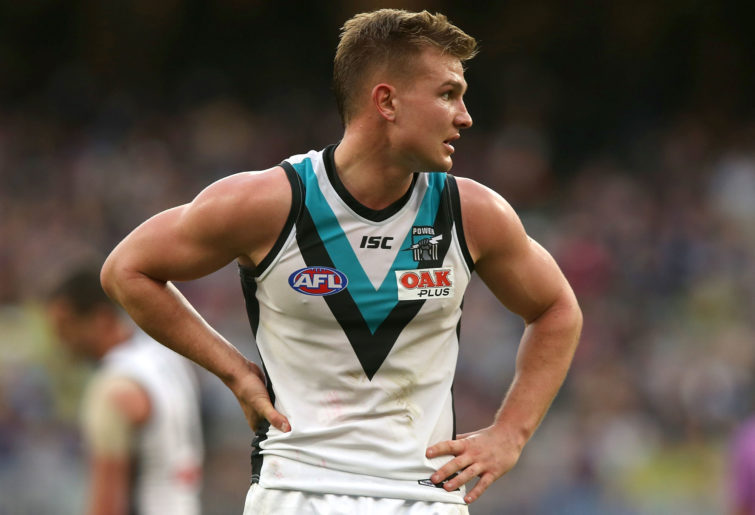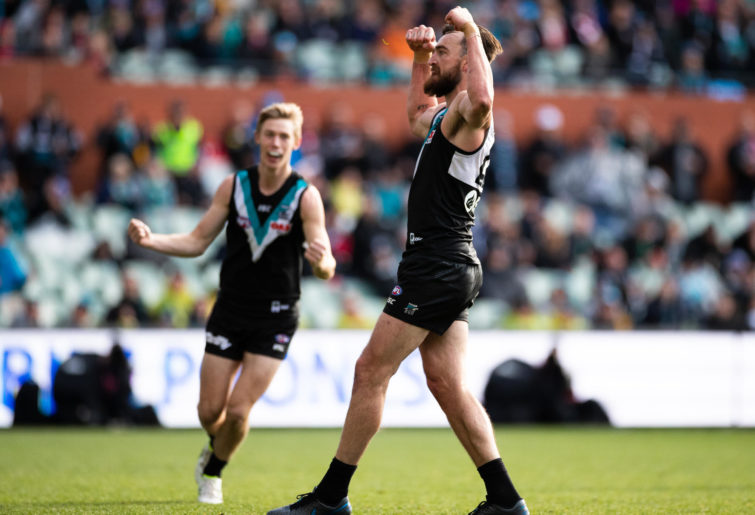No AFL coach entered 2020 under more pressure than Port Adelaide’s Ken Hinkley. But six rounds into the season, his side is a win clear on top of the ladder, and his tenure appears secure.
The Power were only a middling side in 2019 – threatening to make finals but falling in a heap late, a story that isn’t unfamilliar to their fans in recent years.
They did some things well and some poorly, but leaving aside the raw matter of wins and losses for a moment, the numbers suggest they’ve taken some significant steps forward.
An underrated aspect of Port Adelaide’s game last year was their ability to apply pressure. They were No.3 in the AFL for pressure acts and No.2 for tackles when measured per minute of opposition position.
This left them standing head and shoulders above the rest when it came to forcing opposition turnovers. In 2019 the Power forced their opponents to cough up the ball after less than 38 seconds of possession on average – the quickest mark in the competition.
They also boasted a clearance differential of +4.95, proving an elite ability to gain possession whether at the stoppages or through interception.
What they struggled with was retaining the ball and putting it to good use. They could hold onto their own possession for just 40.8 seconds on average, ranked 13th in the league.
Some teams can cover this with lightning-quick scoring ability – Richmond, for example, were only two spots higher in the rankings and won the premiership – but this also is an area where Port struggled.
They scored 1.56 points per minute of possession in 2019 to be ranked 12th overall. Despite their excellent pressure, their propensity for turning it over again saw their defence concede 1.58 points per minute, a middling tenth.

Ollie Wines (Photo by Paul Kane/Getty Images)
Things are a little different in 2020. Their ability to apply pressure remains a strength – they’re top three for both pressure acts and tackles per minute, and forcing an opposition turnover in less than 40 seconds on average.
Unlike 2019, they’ve developed an ability to capitalise on it. Firstly, they’re keeping their hands on the ball much longer – for 47.4 seconds on average, the fourth-longest of any side in the comp.
But most impressive is that they’ve developed real scoring power. They’re putting 1.68 points per minute of possession on the board – best in the comp after six rounds. Their defence is going nicely too, conceding just 1.19, good for second overall.
Many would say that they’ve benefitted from a softer six weeks of fixturing this year compared to others – and you could make a reasonable argument for both sides of this debate.
On one hand, they’ve only played one side in the current top eight, and lost to them. On the other hand, three of the sides they’ve beaten are only out of the eight on percentage, and two (West Coast and Greater Western Sydney) were and still are considered contenders.
Looking at the age and experience of the opposition each team has faced, Port’s opponents have been the fifth youngest and fifth least-experienced on average so far – fair to say they’ve had an easier run to navigate than most.
So perhaps their statistical improvements are a little overstated at the present. Still, there’s reason to argue they’ve taken a material step forward.
The biggest – literally and figuratively – is the presence and form of Charlie Dixon, who is the Power’s most important player and greatest barometer.

Charlie Dixon (Daniel Kalisz/Getty Images)
The numbers show that Port Adelaide’s time in possession, scoring per minute, and total score all increase when Dixon is in the team.
But the contributions of Port’s recent draftees – all of whom were known to possess quality ball use and forward nous when they were drafted – have arguably been just as important.
We already knew after 2019 that Connor Rozee was a star, but Zak Butters has really come on well in 2020. Also, Kane Farrell is going under the radar as an impressive developer.
Quality performances from young draftees has been a hallmark of Hinkley’s tenure – Chad Wingard, Ollie Wines, Sam Powell-Pepper and the 2018 draft trio have all burst onto the scene quickly, and Todd Marshall is developing well too.
He’s great with the kids but Port’s list management strategy hasn’t always provided him with enough of them – often opting to instead pursue mature recruits instead, who’ve been a mixed bag at best.
It’s no coincidence the club have improved since they pivoted back towards the draft. And their three first picks last year – Miles Bergman, Mitch Georgiades and Dylan Williams – all add serious forward-of-the-ball talent. That’s something to look forward to.
Port Adelaide are currently fielding the fourth oldest, fourth most-experienced team of the season – nestled in between the two most recent premiers in Richmond and West Coast.
Over the next two or so years, they’ve got a chance to properly contend for the flag while Dixon and also Travis Boak are still providing elite footy. After that, they may dip for a few seasons while younger players develop and push them up again.
Hinkley appears set to lead that short-term charge. At 5-1 Port must be considered a likely finalist and top-four chance, which would give him one year’s extension automatically, and perhaps impetus to negotiate for more.
Port Adelaide fans appear to remain divided over his position. But six rounds into 2020 you could hardly fault him, and if they maintain their improvement, they’ll be a force come finals.






























































































